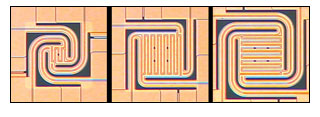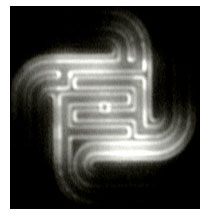WOBURN, Mass., July 8 -- Engineers have created a miniature hotplate that can reach temperatures above 1100°C (2012°F), self-contained within a "laboratory" no bigger than a child's shoe.
The micro-hotplates are only a few dozen microns across (roughly the width of a human hair), yet are capable of serving as substrates, heaters and conductors for thin-film experiments ranging from material analyses to the development of advanced sensors.
Researchers at Boston MicroSystems Inc., a Woburn, Mass., maker of miniaturized microelectromechanical (MEMS)-based sensor platforms, craft the hotplates out of silicon carbide, a strong robust material that can tolerate extreme heat and reach peak temperature in less than one thousandth of a second.

Micro-hotplates crafted of silicon carbide by Boston Microsystems, each consisting of a central plate surrounded by curved tethers. The largest is less than 100 microns (millionths of a meter) across. (Photos on this page: Boston Microsystems Inc.; National Science Foundation)
Silicon carbide is not only stable at high temperatures, it is also impervious to chemical attack from most materials. As a result, the hotplates can be cleaned by merely burning the dirt and debris off the surface.
Contained on a microchip, the tiny "labs" reside within a polycarbonate chamber that can endure near-vacuum pressures. Ports on the chamber's sides allow gases to pass through and feed experiments, and because of the chamber's transparency, researchers can observe experiments with a microscope as they progress.

Infrared image of micro-hotplate. Central plate is only 43 microns (millionths of a meter) across.
The hotplates also contain an integrated temperature gauge and a pair of electrodes. These components allow researchers to test the electrical properties of various materials that may be deposited onto the hotplates. Using the stable, thin-film deposition properties and integrated circuitry of the hotplates, researchers are already developing applications such as oxygen and engine emission sensors. The sensor may have several advantages over devices in today's combustion engines, due to the micro-hotplate's chemical stability, small size, rapid response and low power consumption.

Miniature, polycarbonate laboratory that houses the micro-hotplates. The hotplate is visible as a minute, gold-colored speck in the center of the chamber.
The techniques necessary for crafting and optimizing these MEMS were developed with support from the National Science Foundation Small Business Innovation Research (SBIR) program and SBIR programs at the Department of Energy, Environmental Protection Agency and NASA.
For more information, visit: www.bostonmicrosystems.com